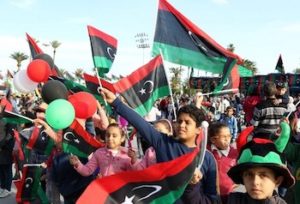
*Libya gained its independence on this date in 1951. Under the 1947 peace treaty with the Allies, Italy relinquished all claims to Libya.
The officially the State of Libya is a country in the Maghreb region in North Africa bordered by the Mediterranean Sea to the north, Egypt to the east, Sudan to the southeast, Chad to the south, Niger to the southwest, Algeria to the west, and Tunisia to the northwest. The sovereign state comprises three historical regions: Tripolitania, Fezzan, and Cyrenaica. With an area of almost 700,000 square miles (1.8 million km2), Libya is the fourth largest country in Africa and the 16th largest country globally. On December 24, 1951, Libya declared its independence as the United Kingdom of Libya, a constitutional and hereditary monarchy under King Idris, Libya's only monarch.
The discovery of significant oil reserves in 1959 and the subsequent income from petroleum sales enabled one of the world's poorest nations to establish an extremely wealthy state. Although oil drastically improved the Libyan government's finances, resentment among some factions began to build over the increased concentration of the nation's wealth in the hands of King Idris. In September 1969, a group of rebel military officers led by Muammar Gaddafi launched what became known as the Al Fateh Revolution. Gaddafi moved to reduce Italian influence; in October 1970, all Italian-owned assets were confiscated, and the 12,000-strong Italian community was expelled from Libya alongside the smaller community of Libyan Jews. The day became a national holiday known as "Vengeance Day."
Libya's increase in prosperity was accompanied by increased internal political repression, and political dissent was made illegal under Law 75 of 1973. Widespread surveillance of the population was carried out through Gaddafi's Revolutionary Committees. Gaddafi also wanted to combat the strict social restrictions imposed on women by the previous regime, establishing the Revolutionary Women's Formation to encourage reform. In 1970, a law was introduced affirming equality of the sexes and insisting on wage parity. In 1971, Gaddafi sponsored the creation of a Libyan General Women's Federation. In 1972, a law was passed criminalizing the marriage of any females under the age of sixteen and ensuring that a woman's consent was a necessary prerequisite for a marriage.
The First civil war came during the Arab Spring movements; Libya experienced a full-scale revolt beginning on February 17, 2011. Libya's authoritarian regime led by Gaddafi put up much more resistance than the regimes in Egypt and Tunisia. The Battle of Sirte was both the last decisive battle and the last one of the First Libyan Civil War, where Gaddafi was captured and killed by NATO-backed forces on October 20, 2011. Sirte was the previous Gaddafi loyalist stronghold and his place of birth. Chaos-ridden Libya has emerged as a significant transit point for people trying to reach Europe. Between 2013 and 2018, nearly 700,000 migrants reached Italy by boat, many of them from Libya. In 2018, Libya's rival leaders agreed to hold parliamentary and presidential elections following a meeting in Paris.